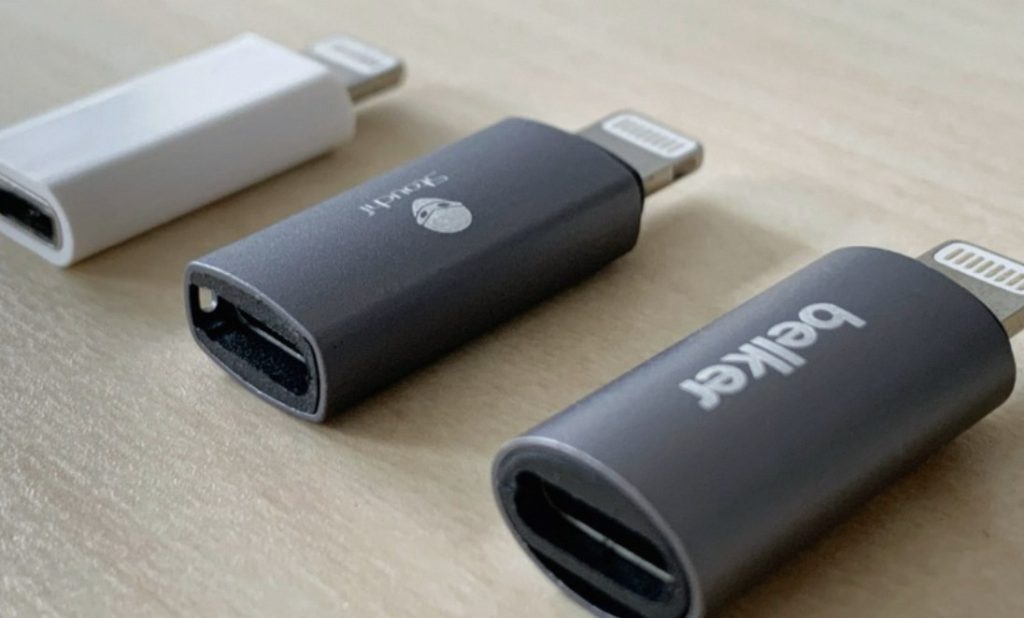In our increasingly tech-dependent world, seamless connectivity between devices is essential. The rise of USB-C as the universal charging standard has created a situation where many Apple users, reliant on Lightning ports for their iPhones and iPads, face compatibility challenges. This is where the USB-C to Lightning adapter steps in, acting as a bridge between these two charging standards and ensuring your devices stay powered and connected.
Part 1: Decoding the Port Landscape – A Tale of Two Standards

The Rise of USB-C: A Multifaceted Port
USB-C has emerged as the frontrunner in the universal charging standard race. This versatile port boasts a user-friendly design, featuring a reversible connector that eliminates the frustration of plugging it in the wrong way. Beyond convenience, USB-C offers faster data transfer speeds and supports various power delivery protocols, enabling rapid charging for a wide range of devices.
The widespread adoption of USB-C by laptop manufacturers, most smartphone brands (excluding Apple), and the accessory industry has created a landscape where most new devices come equipped with USB-C ports. This shift has left Apple users, with their Lightning port-equipped iPhones and iPads, facing potential compatibility challenges when connecting to an increasing number of USB-C peripherals and power banks.
Lightning Persists: Apple’s Proprietary Choice
Apple devices, such as iPhones and iPads, persist in using the Lightning port for charging and data transfer. The Lightning port is advantageous due to its smaller and more robust design compared to previous connectors. However, it’s important to note that the Lightning port remains a proprietary technology exclusive to Apple products. This results in a scenario where iPhone and iPad users may find themselves in need of additional adapters to connect to the increasing array of USB-C peripherals and power sources. With the growing popularity and ubiquity of USB-C in various devices and accessories, the requirement for adapters has become essential for Apple users, ensuring seamless compatibility and connectivity. As a result, many users are seeking solutions to bridge the gap between these differing connection standards, enabling them to maximize the versatility and functionality of their Apple devices.

Part 2: Bridging the Gap – The Functionality of USB-C to Lightning Adapters
Charging Made Simple: Connecting iPhones and iPads to USB-C Power
The primary function of a USB-C to Lightning adapter is to bridge the charging gap between Apple devices and USB-C power sources. The adapter features a USB-C connector on one end and a Lightning connector on the other. This allows you to connect your iPhone or iPad to a USB-C power bank, wall charger, or even your laptop’s USB-C port for convenient charging.
The functionality extends beyond basic charging. Certain USB-C to Lightning adapters support fast charging protocols, enabling you to quickly power up your Apple devices using a compatible USB-C power source. This can significantly reduce charging times, keeping your devices fueled and ready to go.
Data Transfer Potential: Expanding Connectivity Options
While charging is the primary use case, some USB-C to Lightning adapters offer data transfer capabilities as well. This allows you to connect your iPhone or iPad to a computer with a USB-C port for tasks like syncing data, transferring photos and videos, or even restoring your device.
However, it’s important to note that not all USB-C to Lightning adapters support data transfer. When selecting an adapter, ensure it explicitly mentions data transfer capabilities if this functionality is important for you.

MFi Certification: The Seal of Approval for Safe and Reliable Performance
With a growing number of USB-C to Lightning adapters flooding the market, selecting the right one requires careful consideration. A crucial factor is certification. Look for adapters that are Made for iPhone/iPad (MFi). MFi certification signifies that the adapter has been approved by Apple and meets their performance standards.
Non-MFi certified adapters may not function correctly or could even damage your Apple device. While they may be cheaper, the potential risks outweigh any cost savings. Opting for an MFi-certified adapter ensures safe and reliable charging and data transfer for your Apple devices.
Power Delivery and Data Transfer Speeds: Matching Your Needs
Beyond certification, consider the power delivery capabilities of the adapter. If you plan on using fast charging, ensure the adapter supports the specific power delivery protocol used by your power source (e.g., USB Power Delivery). Similarly, for data transfer, check if the adapter supports USB standards like USB 2.0 or USB 3.0 for optimal transfer speeds. Look for adapters that clearly specify their power delivery and data transfer capabilities to ensure they align with your charging and data transfer needs.

Part 4: The Future of Connectivity – A World Beyond Adapters?
The Evolving Landscape: Will USB-C Become the Universal Standard?
The future of compatibility remains uncertain. While USB-C is gaining widespread adoption, Apple has yet to fully embrace this standard on its iPhones and iPads. There are talks of the European Union potentially mandating a universal charging standard for all electronic devices, which could push Apple towards USB-C in the future.
Wireless Charging: A Potential Game Changer (continued)
Wireless charging technology is another factor to consider. While still not as ubiquitous as wired charging, wireless charging offers a convenient and cable-free solution. If wireless charging technology continues to evolve and offers faster charging speeds and wider compatibility, it could potentially render wired adapters obsolete in the long run. However, wired connections still offer advantages for data transfer and may remain a preferred method for certain tasks.
Conclusion: A Bridge Today, a Stepping Stone Tomorrow
USB-C to Lightning adapters serve as a vital bridge in today’s landscape of evolving charging standards. They ensure Apple users can connect their devices to the growing number of USB-C peripherals and power sources.
While the future of compatibility remains uncertain, USB-C to Lightning adapters offer a convenient and reliable solution in the present. Choosing an MFi-certified adapter that aligns with your power delivery and data transfer needs empowers you to stay connected and keep your Apple devices charged and ready to go.
As technology continues to develop, we may see a universal charging standard emerge, potentially eliminating the need for adapters altogether. Wireless charging might also become a more dominant force. However, for now, USB-C to Lightning adapters remain a valuable tool for navigating the current landscape of charging standards.



